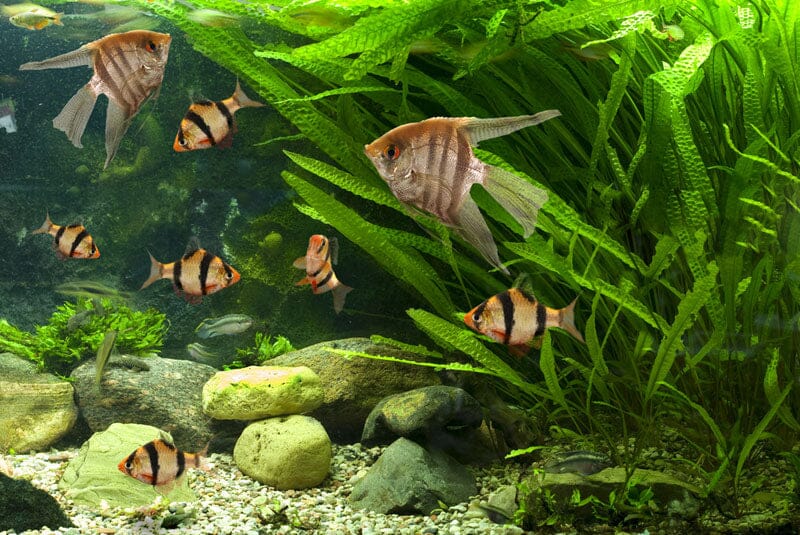An aquarium's harmonious balance enhances any space's ambiance, projecting a serene reflection of nature's beauty. One essential element in achieving and maintaining this harmony is the use of effective biological filtration. Among the various methods employed, Bio Balls stand out due to their specific role in regulating the water parameters of your aquarium.
Bio Balls and Their Contribution to Biological Filtration
Biological filtration revolves around the nitrogen cycle, a vital process ensuring water quality remains conducive to aquatic life. This cycle transforms harmful substances like ammonia and nitrite into less toxic nitrate through a process referred to as nitrification.
Bio Balls are a form of aquarium filter media that serve as a rich dwelling for beneficial bacteria, essential facilitators of the nitrification process. These spherical plastic devices offer a large surface area that encourages bacteria growth and biofilm formation.
Thanks to their unique porous structure, Bio Balls provide an optimal environment for the growth of bacterial colonies.
What Are Bio Balls?
Bio balls are small, usually plastic, biodegradable spheres covered in numerous tiny ridges and pores. Their core purpose is to provide a substantial surface area for beneficial bacteria to thrive, facilitating the efficient decomposition of harmful organic matter within the aquarium. This natural process of biomineralization and biosorption, with the help of these microbes, contributes significantly to maintaining a clean and healthy environment for the aquatic residents.

The Science Behind Bio Balls
Understanding the science behind bio balls requires a basic knowledge of bacteria, the unsung heroes of our ecosystem. Beneficial bacteria, particularly those involved in the nitrogen cycle, colonize the surface of the bio balls, using the available organic matter to fuel their life processes. These bacteria employ extracellular enzymes to break down complex compounds into simpler substances.
One group of these bacteria, known as nitrifying bacteria, process harmful ammonia released by fish and other inhabitants, converting it into nitrites and eventually nitrates, which are less toxic and can be absorbed by plants or removed during water changes. In this way, bio balls are essential for fostering a healthy bacterial community within the aquarium filtration system.
Bio Balls and Algae
Bio balls and algae share an interesting relationship. Excessive algae growth in an aquarium can often indicate an imbalance in the ecosystem, such as overfeeding or inadequate filtration.
While bio balls don't directly combat algae, they contribute to a balanced environment where algae growth is controlled. They do this by promoting the growth of beneficial bacteria that outcompete algae for nutrients, reducing its chances of overpopulation.
Bio Balls vs. Other Filter Media
Comparing bio balls to other filter media, such as resin, ceramic rings, or sponges, is akin to comparing different soil types in an ecosystem. Each has its strengths and weaknesses, and the choice often depends on the specific needs of the aquarium and its inhabitants.
Bio balls excel in their capability to house bacteria due to their extensive surface area. While they do not directly interact with certain substances like chitin, proteins, or polysaccharides, they promote the growth of bacteria that do.
In other words, they are the perfect base for the microorganisms that engage in the heavy lifting of mineral processing and organic waste degradation.
Bio Balls and Their Effects on Aquatic Health and Water Purity
Bio Balls significantly influence the health of your fish by supporting the nitrogen cycle and subsequently removing harmful toxins from the water. They help to maintain steady water quality, offering a safe and healthy habitat for your aquatic friends.

Versatility of Bio Balls: Usage in Freshwater and Saltwater Aquariums
Though a wide range of aquarium filters and different filter media are available, Bio Balls have a universal appeal. They are effective in freshwater and saltwater tanks, albeit their efficacy may vary depending on the particular needs of the aquarium's inhabitants.
While frequently found in freshwater aquariums, Bio Balls can also benefit saltwater setups, particularly in fish-only tanks or those with live rock configurations.
Bio Balls Versus Ceramic Rings: A Comparative Insight
The choice of aquarium filter media often boils down to comparing Bio Balls and ceramic rings. Both aim to serve the same basic function – hosting beneficial bacteria. The choice depends on the specific demands of your aquarium. Bio Balls offer an extensive surface area, whereas ceramic rings can accommodate more bacteria internally due to their higher porosity. For a detailed comparison between these two filter media, you may refer to FishLab.
Maintenance Protocol for Bio Balls to Ensure Optimal Aquarium Conditions
Like any other aquarium filter media, Bio Balls need routine care to perform efficiently. Cleaning Bio Balls is a straightforward process involving a gentle rinse with tank water to dislodge accumulated debris without disrupting the resident bacterial colony.
Remember, chlorinated tap water should never be used for cleaning as it could kill bacteria and interfere with the nitrogen cycle.
Material Composition and Durability of Bio Balls
Bio Balls are typically made from durable, lightweight plastic to maximize surface area. Their durability and longevity make them a cost-effective option for many aquarium enthusiasts.
Bio Balls can serve for several years with appropriate maintenance, underscoring their value as biological filter media. For additional insights on various aquarium materials and their lifespan, Aquarium Co-Op offers a plethora of useful information.
Bio Balls' Role in Decomposition and Life Support Systems for Aquatic Life
Bio Balls play a significant role in breaking down waste substances in the aquarium. As water passes over the Bio Balls, the resident bacteria initiate the breakdown of harmful substances, preventing toxin accumulation that can pose a threat to your aquatic life. This role makes Bio Balls a key component in aquariums' overall life support systems.
Looking Ahead: Are Bio Balls a Long-term Solution?
Given their durability, performance, and ease of use, Bio Balls will likely remain integral to the aquarium filtration universe. Their practicality and efficacy in maintaining water quality make them suitable for both beginners and seasoned aquarists.
Frequently Asked Questions
Can Bio Balls be utilized in all types of aquarium environments?
Bio Balls are versatile and can be deployed in saltwater and freshwater aquariums. Yet, your specific aquarium requirements must dictate your filter media choice.
What is the suggested cleaning routine for Bio Balls?
While the cleaning frequency for Bio Balls may differ. Generally, a light rinse every two months or so is adequate. It's crucial not to cleanse all your Bio Balls simultaneously to maintain the stability of the bacterial community.
Is it possible to use Bio Balls in smaller aquarium setups?
Yes, Bio Balls can indeed be fitted into petite aquariums too. However, considering their size, they might not be as space-saving as other types of filter media, like ceramic rings or sponge filters.





